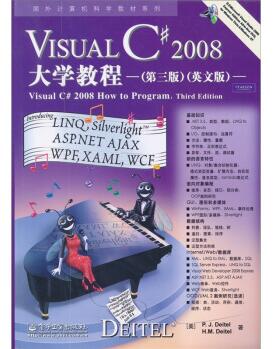Visual C# 2008大学教程 英文版 作者:(美)戴特尔
Visual C# 2008大学教程 英文版 出版社:电子工业出版社
Visual C# 2008大学教程 英文版 内容简介
《Visual C#2008大学教程(英文版)(第3版)》是一本C#编程方面的优秀教材,全面介绍了C#编程的原理和方法,涉及类与对象、控制语句、方法、数组、继承、多态、异常处理、GUI、多线程、多媒体、XML、数据库与SQL、ASP .NET、Web服务、网络、查找与排序、数据结构、泛型、集合等基本概念及应用方法。本书介绍C#版本 Visual C# 2008的关键新特性,包括LINQ(语言集成查询)特性、使用LINQ to SQL的数据库、WPF GUI和图形、WCF Web服务、ASP.NET 3.5与ASP.NET AJAX、Silverlight 2技术、支持LINQ的新语言特性、隐式类型局部变量和自实现属性。
读者对象:本书可作为高等院校相关专业的编程语言教材和C#编程教材,也是软件设计人员进行C#程序开发的宝贵参考资料。
Visual C# 2008大学教程 英文版 目录
Contents
Chapter Introduction to Computers, the Internet and Visual C#
1.1 Introduction
1.2 What Is a Computer?
1.3 Computer Organization
1.4 Personal Computing, Distributed Computing and Client/Server Computing
1.5 Hardware Trends
1.6 Microsoft’sWindows® Operating System
1.7 Machine Languages, Assembly Languages and High-Level Languages
1.8 Visual Basic
1.9 C, C++ and Java
1.10 Visual C#
1.11 Other High-Level Languages
1.12 Structured Programming
1.13 Key Software Trend: Object Technology
1.14 The Internet and the World Wide Web
1.15 Extensible Markup Language (XML)
1.16 Introduction to Microsoft .NET
1.17 The .NET Framework and the Common Language Runtime
1.18 Test-Driving a C# Advanced Painter Application
1.19 (Only Required Section of the Case Study) Software Engineering Case Study: Introduction to Object Technology and the UML
1.20 Wrap-Up
1.21 Web Resources
Chapter Dive Into® Visual C# Express
2.1 Introduction
2.2 Overview of the Visual Studio IDE
2.3 Menu Bar and Toolbar
2.4 Navigating the Visual Studio IDE
2.5 Using Help
2.6 Using Visual Programming to Create a Simple Program that Displays Text and an Image
2.7 Wrap-Up
2.8 Web Resources
Chapter Introduction to C# Applications
3.1 Introduction
3.2 A Simple C# Application: Displaying a Line of Text
3.3 Creating a Simple Application in Visual C# Express
3.4 Modifying Your Simple C# Application
3.5 Formatting Text with Console.Write and Console.WriteLine
3.6 Another C# Application: Adding Integers
3.7 Memory Concepts
3.8 Arithmetic
3.9 Decision Making: Equality and Relational Operators
3.10 (Optional) Software Engineering Case Study: Examining the ATM Requirements Document
3.11 Wrap-Up
3.12 Web Resources
Chapter Introduction to Classes and Objects
4.1 Introduction
4.2 Classes, Objects, Methods, Properties and Instance Variables
4.3 Declaring a Classwith aMethod and Instantiating an Object of a Class
4.4 Declaring a Method with a Parameter
4.5 Instance Variables and Properties
4.6 UML Class Diagram with a Property
4.7 Software Engineering with Properties and set and get Accessors
4.8 Auto-Implemented Properties
4.9 Value Types vs. Reference Types
4.10 Initializing Objects with Constructors
4.11 Floating-Point Numbers and Type decimal
4.12 (Optional) Software Engineering Case Study: Identifying the Classes in the ATM Requirements Document
4.13 Wrap-Up
Chapter Control Statements: Part
5.1 Introduction
5.2 Algorithms
5.3 Pseudocode
5.4 Control Structures
5.5 if Single-Selection Statement
5.6 if...else Double-Selection Statement
5.7 while Repetition Statement
5.8 Formulating Algorithms: Counter-Controlled Repetition
5.9 Formulating Algorithms: Sentinel-Controlled Repetition
5.10 Formulating Algorithms: Nested Control Statements
5.11 Compound Assignment Operators
5.12 Increment and Decrement Operators
5.13 Simple Types
5.14 (Optional) Software Engineering Case Study: Identifying Class Attributes in the ATM System
5.15 Wrap-Up
Chapter Control Statements: Part
6.1 Introduction
6.2 Essentials of Counter-Controlled Repetition
6.3 for Repetition Statement
6.4 Examples Using the for Statement
6.5 do...while Repetition Statement
6.6 switch Multiple-Selection Statement
6.7 break and continue Statements
6.8 Logical Operators
6.9 Structured-Programming Summary
6.10 (Optional) Software Engineering Case Study: Identifying Objects’ States and Activities in the ATM System
6.11 Wrap-Up
Chapter Methods: A Deeper Look
7.1 Introduction
7.2 Packaging Code in C#
7.3 static Methods, static Variables and Class Math
7.4 Declaring Methods with Multiple Parameters
7.5 Notes on Declaring and Using Methods
7.6 Method-Call Stack and Activation Records
7.7 Argument Promotion and Casting
7.8 The .NET Framework Class Library
7.9 Case Study: Random-Number Generation
7.10 Case Study: A Game of Chance (Introducing Enumerations)
7.11 Scope of Declarations
7.12 Method Overloading
7.13 Recursion
7.14 Passing Arguments: Pass-by-Value vs. Pass-by-Reference
7.15 (Optional) Software Engineering Case Study: Identifying Class Operations in the ATM System
7.16 Wrap-Up
Chapter Arrays
8.1 Introduction
8.2 Arrays
8.3 Declaring and Creating Arrays
8.4 Examples Using Arrays
8.5 Case Study: Card Shuffling and Dealing Simulation
8.6 foreach Statement
8.7 Passing Arrays and Array Elements to Methods
8.8 Passing Arrays by Value and by Reference
8.9 Case Study: Class GradeBook Using an Array to Store Grades
8.10 Multidimensional Arrays
8.11 Case Study: Class GradeBook Using a Rectangular Array
8.12 Variable-Length Argument Lists
8.13 Using Command-Line Arguments
8.14 (Optional) Software Engineering Case Study: Collaboration Among Objects in the ATM System
8.15 Wrap-Up
Chapter Introduction to LINQ and Generic Collections
9.1 Introduction
9.2 Querying an Array Using LINQ
9.3 Introduction to Collections
9.4 Querying a Generic Collection Using LINQ
9.5 Wrap-Up
9.6 Deitel LINQ Resource Center
Chapter Classes and Objects: A Deeper Look
10.1 Introduction
10.2 Time Class Case Study
10.3 Controlling Access to Members
10.4 Referring to the Current Object’s Members with the this Reference
10.5 Indexers
10.6 Time Class Case Study: Overloaded Constructors
10.7 Default and Parameterless Constructors
10.8 Composition
10.9 Garbage Collection and Destructors
10.10 static Class Members
10.11 readonly Instance Variables
10.12 Software Reusability
10.13 Data Abstraction and Encapsulation
10.14 Time Class Case Study: Creating Class Libraries
10.15 internal Access
10.16 Class View and Object Browser
10.17 Object Initializers
10.18 Time Class Case Study: Extension Methods
10.19 Delegates
10.20 Lambda Expressions
10.21 Anonymous Types
10.22 (Optional) Software Engineering Case Study: Starting to Program the Classes of the ATM System
10.23 Wrap-Up
Chapter Object-Oriented Programming: Inheritance
11.1 Introduction
11.2 Base Classes and Derived Classes
11.3 protected Members
11.4 Relationship between Base Classes and Derived Classes
11.5 Constructors in Derived Classes
11.6 Software Engineering with Inheritance
11.7 Class object
11.8 Wrap-Up
Chapter Polymorphism, Interfaces and Operator Overloading
12.1 Introduction
12.2 Polymorphism Examples
12.3 Demonstrating Polymorphic Behavior
12.4 Abstract Classes and Methods
12.5 Case Study: Payroll System Using Polymorphism
12.6 sealed Methods and Classes
12.7 Case Study: Creating and Using Interfaces
12.8 Operator Overloading
12.9 (Optional) Software Engineering Case Study: Incorporating Inheritance and Polymorphism into the ATM System
12.10 Wrap-Up
Chapter Exception Handling
13.1 Introduction
13.2 Exception-Handling Overview
13.3 Example: Divide by Zero without Exception Handling
13.4 Example: Handling DivideByZeroExceptions and FormatExceptions
13.5 .NET Exception Hierarchy
13.6 finally Block
13.7 Exception Properties
13.8 User-Defined Exception Classes
13.9 Wrap-Up
Chapter Graphical User Interfaces with Windows Forms: Part
14.1 Introduction
14.2 Windows Forms
14.3 Event Handling
14.4 Control Properties and Layout
14.5 Labels, TextBoxes and Buttons
14.6 GroupBoxes and Panels
14.7 CheckBoxes and RadioButtons
14.8 PictureBoxes
14.9 ToolTips
14.10 NumericUpDown Control
14.11 Mouse-Event Handling
14.12 Keyboard-Event Handling
14.13 Wrap-Up
Chapter Graphical User Interfaces with Windows Forms: Part
15.1 Introduction
15.2 Menus
15.3 MonthCalendar Control
15.4 DateTimePicker Control
15.5 LinkLabel Control
15.6 ListBox Control
15.7 CheckedListBox Control
15.8 ComboBox Control
15.9 TreeView Control
15.10 ListView Control
15.11 TabControl Control
15.12 Multiple Document Interface (MDI) Windows
15.13 Visual Inheritance
15.14 User-Defined Controls
15.15 Wrap-Up
Chapter GUI with Windows Presentation Foundation
16.1 Introduction
16.2 Windows Presentation Foundation (WPF)
16.3 XML Basics
16.4 Structuring Data
16.5 XML Namespaces
16.6 Declarative GUI Programming Using XAML
16.7 Creating a WPF Application in Visual C# Express
16.8 Laying Out Controls
16.9 Event Handling
16.10 Commands and Common Application Tasks
16.11 WPF GUI Customization
16.12 Using Styles to Change a Control’s Appearance
16.13 Customizing Windows
16.14 Defining a Control’s Appearance with Control Templates
16.15 Data-Driven GUIs with Data Binding
16.16 Wrap-Up
16.17 Web Resources
Chapter WPF Graphics and Multimedia
17.1 Introduction
17.2 Controlling Fonts
17.3 Basic Shapes
17.4 Polygons and Polylines
17.5 Brushes
17.6 Transforms
17.7 WPF Customization: A Television GUI
17.8 Animations
17.9 (Optional) -D Objects and Transforms
17.10 Wrap-Up
Chapter Strings, Characters and Regular Expressions
18.1 Introduction
18.2 Fundamentals of Characters and Strings
18.3 string Constructors
18.4 string Indexer, Length Property and CopyTo Method
18.5 Comparing strings
18.6 Locating Characters and Substrings in strings
18.7 Extracting Substrings from strings
18.8 Concatenating stringss
18.9 Miscellaneous string Methods
18.10 Class StringBuilder
18.11 Length and Capacity Properties, EnsureCapacity Method and Indexer of Class StringBuilder
18.12 Append and AppendFormat Methods of Class StringBuilder
18.13 Insert, Remove and Replace Methods of Class StringBuilder
18.14 Char Methods
18.15 Card Shuffling and Dealing Simulation
18.16 Introduction to Regular-Expression Processing
18.17 Wrap-Up
Chapter Files and Streams
19.1 Introduction
19.2 Data Hierarchy
19.3 Files and Streams
19.4 Classes File and Directory
19.5 Creating a Sequential-Access Text File
19.6 Reading Data from a Sequential-Access Text File
19.7 Case Study: Credit Inquiry Program Using LINQ
19.8 Serialization
19.9 Creating a Sequential-Access File Using Object Serialization
19.10 Reading and Deserializing Data from a Binary File
19.11 Wrap-Up
Chapter XML and LINQ to XML
20.1 Introduction
20.2 Document Type Definitions (DTDs)
20.3 W3C XML Schema Documents
20.4 Extensible Stylesheet Language and XSL Transformations
20.5 LINQ to XML: Document Object Model (DOM)
20.6 LINQ to XML Class Hierarchy
20.7 LINQ to XML: Namespaces and Creating Documments722
20.8 XSLT with Class XslCompiledTransform
20.9 Wrap-Up
20.10 Web Resources
Chapter Databases and LINQ to SQL
21.1 Introduction
21.2 Relational Databases
21.3 Relational Database Overview: Books Database
21.4 SQL
21.5 LINQ to SQL
21.6 LINQ to SQL: Extracting Information from a Database
21.7 More Complex LINQ Queries and Data Binding
21.8 Retrieving Data from Multiple Tables with LINQ
21.9 Creating a Master/Detail View Application
21.10 Programming with LINQ to SQL: Address-Book Case Study
21.11 Wrap-Up
21.12 Tools and Web Resources
Chapter ASP.NET .5 and ASP.NET AJAX
22.1 Introduction
22.2 Simple HTTP Transactions
22.3 Multitier Application Architecture
22.4 Creating and Running a Simple Web-Form Example
22.5 Web Controls
22.6 Session Tracking
22.7 Case Study: Connecting to a Database in ASP.NET
22.8 Case Study: Secure Books Database Application
22.9 ASP.NET AJAX
22.10 New ASP.NET .5 Data Controls
22.11 Wrap-Up
22.12 Web Resources
Chapter Windows Communication Foundation (WCF) Web Services
23.1 Introduction
23.2 WCF Services Basics
23.3 Simple Object Access Protocol (SOAP)
23.4 Representational State Transfer (REST)
23.5 JavaScript Object Notation (JSON)
23.6 Publishing and Consuming SOAP-Based Web Services
23.7 Publishing and Consuming REST-Based XML Web Services
23.8 Publishing and Consuming REST-Based JSON Web Services
23.9 Blackjack Web Service: Using Session Tracking in a SOAP-Based Web Service
23.10 Airline Reservation Web Service: Database Access and Invoking a Service from ASP.NET
23.12 Wrap-Up
23.13 Deitel Web Services Resource Centers
Chapter Silverlight, Rich Internet Applications and Multimedia
24.1 Introduction
24.2 Platform Overview
24.3 Silverlight Runtime and Tools Installation
24.4 Building a Silverlight WeatherViewer Application
24.5 Animations and the FlickrViewer
24.6 Images and Deep Zoom
24.7 Audio and Video
24.8 Isolated Storage
24.9 Silverlight Demos and Web Resources
24.10 Wrap-Up
Chapter Searching and Sorting
25.1 Introduction
25.2 Searching Algorithms
25.3 Sorting Algorithms
25.4 Wrap-Up
Chapter Data Structures
26.1 Introduction
26.2 Simple-Type structs, Boxing and Unboxing
26.3 Self-Referential Classes
26.4 Linked Lists
26.5 Stacks
26.6 Queues
26.7 Trees
26.8 Wrap-Up
Chapter Generics
27.1 Introduction
27.2 Motivation for Generic Methods
27.3 Generic-Method Implementation
27.4 Type Constraints
27.5 Overloading Generic Methods
27.6 Generic Classes
27.7 Wrap-Up
Chapter Collections
28.1 Introduction
28.2 Collections Overview
28.3 Class Array and Enumerators
28.4 Nongeneric Collections
28.5 Generic Collections
28.6 Wrap-Up
Appendix A Operator Precedence Chart
Appendix B Simple Types
Appendix C Number Systems
Appendix D ATM Case Study Code
Appendix E UML : Additional Diagram Types
Appendix F ASCII Character Set
Appendix G Unicode®
Appendix H Using the Visual C# Debugger
Index

→→→→→→→→→→→→→→→→→→→→查找获取




评论